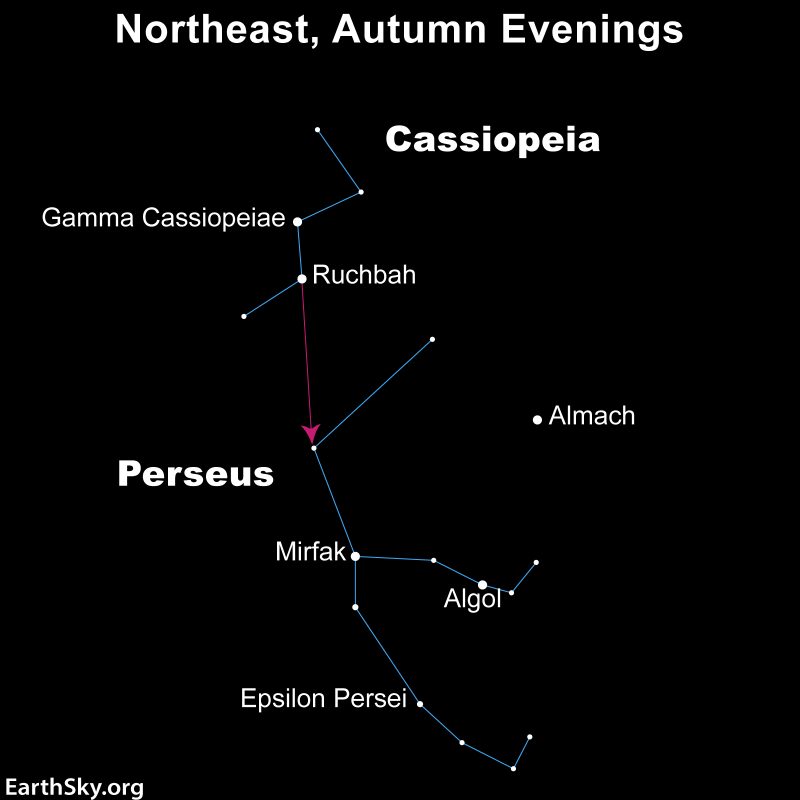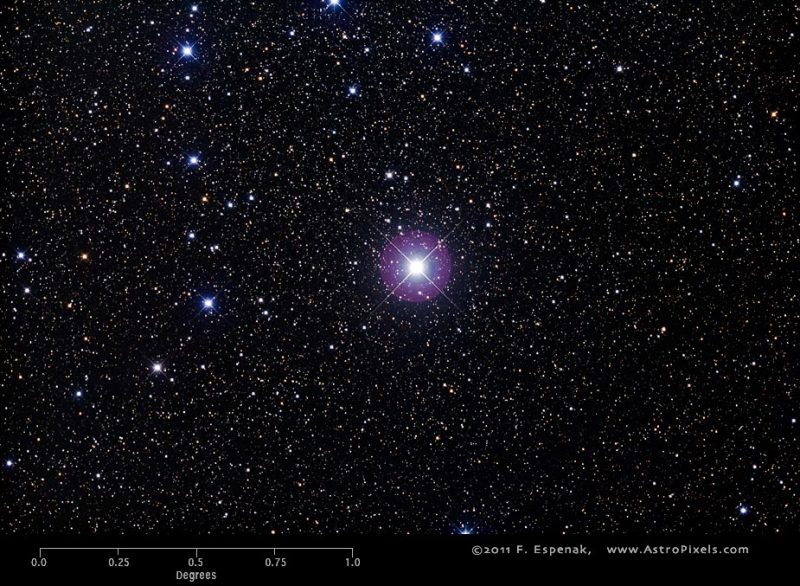
Mirfak is the brightest star in the constellation Perseus the Hero. This star and its constellation lie high in the east-northeast on December evenings, as seen from the Northern Hemisphere. It makes a great companion to the sky’s most celebrated eclipsing binary star, which is called Algol, sometimes called the Ghoul Star or Demon Star. Mirfak and Algol are about 10 degrees, or a fist-width, apart in Perseus. As you watch the variable star Algol dip and then regain brightness, compare it to the more constant Mirfak. You’ll soon see why Algol perplexed the early stargazers, and why Mirfak seemed steadfast in comparison.
The 2024 lunar calendars are here! Best Christmas gifts in the universe! Check ’em out here.
How to find Mirfak
The name Mirfak comes from Arabic and means the Elbow of the Pleiades. Mirfak is also another name for Alpha Persei. In fact, the constellation Perseus lies due north of the Pleiades star cluster, also called the Seven Sisters. You can find Mirfak and Perseus between the Pleiades cluster and Polaris, the North Star.

Or you can also take a more direct route to Mirfak, if you’re familiar with the M or W-shaped constellation Cassiopeia the Queen. Draw an imaginary line through the Cassiopeia stars Navi (Gamma Cassiopeiae) and Ruchbah to jump over to Mirfak.
Mirfak is the lone star of Perseus that stands out in moderately light-polluted skies, as its brilliance matches that of the stars of the famous Big Dipper.
Science of Alpha Persei
At a distance of about 510 light-years, Mirfak lies much farther than the Big Dipper stars, so this star has to be intrinsically very luminous to shine so brightly in our sky. If Mirfak stood at the sun’s distance from Earth, its disk would cover several thousand times more sky. Moreover, Mirfak would shine thousands of times more brightly than our sun. In fact, it’s about 5,000 times more luminous than our sun.
On a dark night, you might discern a faint array of stars clustering around Mirfak, a bejeweled realm of the heavens that glitters all the more in binoculars. This assemblage of stars is known as the Alpha Persei Moving Group (Melotte 20), of which Mirfak is the most prominent member. Although some feel that this stellar grouping is too dispersed to be called a star cluster, these stars nonetheless move in the same general direction through space and were born from the same cloud of gas and dust some 30 to 50 million years ago.

Bottom line: Mirfak is the brightest star in the constellation Perseus and is visible even from light-polluted locations. This star is a member of the Alpha Persei Moving Cluster of stars.
The post Mirfak is the brightest star in Perseus the Hero first appeared on EarthSky.
from EarthSky https://ift.tt/yoXjkrz

Mirfak is the brightest star in the constellation Perseus the Hero. This star and its constellation lie high in the east-northeast on December evenings, as seen from the Northern Hemisphere. It makes a great companion to the sky’s most celebrated eclipsing binary star, which is called Algol, sometimes called the Ghoul Star or Demon Star. Mirfak and Algol are about 10 degrees, or a fist-width, apart in Perseus. As you watch the variable star Algol dip and then regain brightness, compare it to the more constant Mirfak. You’ll soon see why Algol perplexed the early stargazers, and why Mirfak seemed steadfast in comparison.
The 2024 lunar calendars are here! Best Christmas gifts in the universe! Check ’em out here.
How to find Mirfak
The name Mirfak comes from Arabic and means the Elbow of the Pleiades. Mirfak is also another name for Alpha Persei. In fact, the constellation Perseus lies due north of the Pleiades star cluster, also called the Seven Sisters. You can find Mirfak and Perseus between the Pleiades cluster and Polaris, the North Star.

Or you can also take a more direct route to Mirfak, if you’re familiar with the M or W-shaped constellation Cassiopeia the Queen. Draw an imaginary line through the Cassiopeia stars Navi (Gamma Cassiopeiae) and Ruchbah to jump over to Mirfak.
Mirfak is the lone star of Perseus that stands out in moderately light-polluted skies, as its brilliance matches that of the stars of the famous Big Dipper.
Science of Alpha Persei
At a distance of about 510 light-years, Mirfak lies much farther than the Big Dipper stars, so this star has to be intrinsically very luminous to shine so brightly in our sky. If Mirfak stood at the sun’s distance from Earth, its disk would cover several thousand times more sky. Moreover, Mirfak would shine thousands of times more brightly than our sun. In fact, it’s about 5,000 times more luminous than our sun.
On a dark night, you might discern a faint array of stars clustering around Mirfak, a bejeweled realm of the heavens that glitters all the more in binoculars. This assemblage of stars is known as the Alpha Persei Moving Group (Melotte 20), of which Mirfak is the most prominent member. Although some feel that this stellar grouping is too dispersed to be called a star cluster, these stars nonetheless move in the same general direction through space and were born from the same cloud of gas and dust some 30 to 50 million years ago.

Bottom line: Mirfak is the brightest star in the constellation Perseus and is visible even from light-polluted locations. This star is a member of the Alpha Persei Moving Cluster of stars.
The post Mirfak is the brightest star in Perseus the Hero first appeared on EarthSky.
from EarthSky https://ift.tt/yoXjkrz

Aucun commentaire:
Enregistrer un commentaire